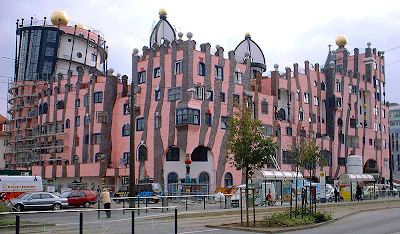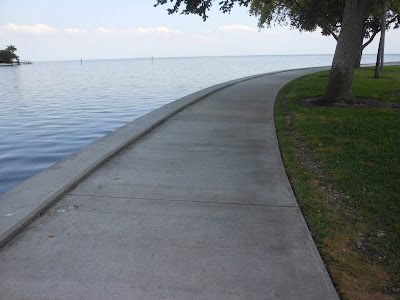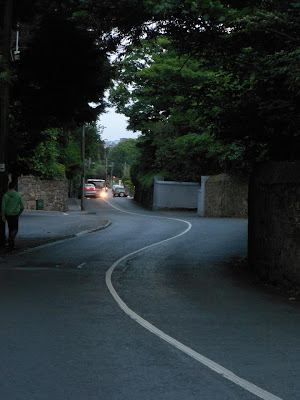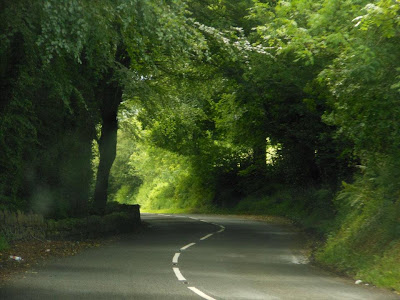Our eyes and legs enjoy a
swerve. A serpentine turn or luscious curve. We live in a tyranny of straight
lines, in a universe of square boxes. Ours is an age ruled by perpendicularity.
But we also need voluptuous swirls, sensuous spirals, looping swerves,
sumptuous swooshes, and fanciful whorls. They help us to enter into and conduct
ourselves through the flow of things and to establish or recover bodily rhythm.
Start counting the number
of straight lines in the room you occupy right now, and you may be sitting
there until kingdom come. They likely govern the patterns in the ceiling and
floor, the structure of the furniture, windows and doors, and so much more from
the hundreds located in the configuration of a single razor blade to those
found in the format, composition and content of books, to the lines inherent in
the very construction of the building itself.
Now, step outside on a path
with alluring curves, and you just may be drawn into a world of
ever-proliferating wonder and probably a few surprises and hidden secrets.
Rarely, in fact, does one encounter a distinct right angle in the natural
world, except perhaps at a less perceptible, more microscopic level: in, say,
the veination of leaves or the cleavage of minerals and rocks. Nature, we could
provocatively claim, appears to abhor a straight line.

The English painter,
printmaker and critic William Hogarth first speculated that an undulating or
serpentine line provides the basis for a powerful experience of—and hence
theory about—visual beauty. He studied reactions to a range of shapes in
women’s corsets and discovered that people often prefer those with a particular
curvature. From such a perspective, an “S-curve” can generate a seductive
aesthetic tension between variety and uniformity. Too great a deviation from
such a norm is exhausting for the eye; to little courts the risk of monotony.
The serpentine line can be found in a great range of aesthetically interesting
phenomena from the decorative elements in fashion to the curves in a woman’s
body, and it may be responsible, in part, for creating a type of more
objective—or at least inter-subjective—beauty.

Artists and architects, of
course, occasionally challenge the hegemony of the straight line, right angle
and square frame by introducing curvature into their works. Both Antoni Gaudi
and Friedrich Hundertwasser employed playful curvilinear forms in their
buildings to great success and delight. Hundertwasser, in fact, authored a
“Mold Manifesto” that critiqued the proliferation of straight lines, bland
functionalism, and blind adherence to rationalism in architecture and, in turn,
celebrated the fluidity one finds in more organic shapes and materials. “It is time people themselves rebelled against
being confined in box-constructions, in the same way as hens and rabbits are
confined in cage-constructions that are equally foreign to their nature,” he
wrote. He added: “This jungle of straight lines, which
increasingly hems us in like prisoners in a jail, must be uprooted. Until
now man has always uprooted the jungle in which he found himself and set
himself free. But first he has to become aware that he is living in a jungle,
for this jungle has grown up surreptitiously, unnoticed by the population.”
Hundertwasser extended this perspective to include physical movement as well: “The
line I trace with my feet walking to the museum is more important and more
beautiful than the lines I find there hung up on the walls.”

With sidewalks and other
walkscapes, alternatives to or disruptions of the uniformity and predictability
of the grid plan can serve as welcome aesthetic features in an urban environment,
introducing novelty or the unknown into the experience of place. In rural
areas, some streams that have been straightened (de-meandered) to expedite the
goal of efficiency in water delivery have been later re-meandered so as to
return previously existing curves because of strong local protests and
reactions against the straightening of the water flow, which leads
inadvertently to “blandscapes” or a sense of boredom in travel by boat or foot.

In a broader sense, what we
are here considering is the “shape” that a walk takes, the particular geometric
form, experiential path or dynamic pulse that it follows, responds to, or
amplifies as one journeys through place. Thoreau, for example, confessed to
walking frequently in a parabola, “like one of those cometary orbits, which
have been thought to be non-returning curves.”
“A line is a dot that went
for a walk,” the artist Paul Klee once proclaimed. Indeed, this very point
(claim) seems designed to set static points (dots) in motion and to link them
with other geographical positions or aesthetic dispositions. The video below is
one short illustration inspired by Klee’s proclamation:
Klee, too, spoke of drawing
and, by extension artistic creation, in terms of “taking a line for a walk.”
Here, the hand assumes the role of the foot in movement across paper,
generating a path that evolves into an image or picture. What the remark
likewise gestures toward is the notion that there are vastly different kinds of
lines just as there are sundry styles and types of walks. A penciled or painted
line, like a walk, can ramble and wander or proudly strut about or dawdle in minute,
impressionistic details, or rush headlong to a pre-given destination.
Interestingly, one artist has combined the actions
of the hand with those of the foot into a piece he styles, “Walking Drawing.”
Essentially, Tom Marioni strolled back and forth between ends of a long
horizontal sheet of paper affixed to the wall while drawing utensils were attached
to his body at the hip. The work both records his actual walk—his paces across
a measured space; his repeated comings and goings—and also depicts a rolling
landscape via a series of undulating brown and green lines, intimating an
autumnal scene. It invites us to
ponder the question, “Did the walk fashion the work (and the landscape itself
make a picture), or did the work inspire a walk (and the resultant picture form
a landscape)?” In either case, the conscious activities of the walker (artist),
though initially intentional and directed, are downplayed, subordinated to the
activity of walking itself, which asserts its own creative potential. The title
of the work—composed of two present-tense verbs, walking and drawing—redoubles
the ambiguity and suggests the chiasmatic and bivalent aspects between walker
and walk; art and earth; motion and static representation, and even reader
(critic) and landscape (text). The drawing is accomplished via the line of
walking and is itself a drawing of walking. The work reminds us quietly, too,
that walking involves a form of cyclical rolling—from heel to ball to toe of
foot and back again—as one old English etymology for walk, from “to roll” or
“roll up”, suggests.

In San Francisco, I once
chanced across and followed a purple painted line that snaked and wended its way along
the sidewalk through the Mission District of the city for quite a few blocks. As I pursued the continuous marking, I
was in a sense also “drawn” into the neighborhood myself, anticipating a
possible surprise or revelation at its eventual terminus.

In New York, an artist known
as Momo painted a thin orange line that travels around the city for eight
uninterrupted miles—through SoHo, Greenwich Village, and the Lower East
Side—spelling out his name in the process on the streets and sidewalks. Apparently,
New Yorkers have walked upon the colored trace—the world’s largest graffiti
tag—for years without realizing it. Momo put together a short film (below) of
the line, which was inspired by a series of purple footprints emblazoned on the
sidewalk that he had seen and followed as a child. The path they formed
stretched around the city and led to a community garden space named “The Garden
of Eden” which the city, unfortunately, had bulldozed.
Another artist,
Eve Mosher, has used a winding waterline as a way to show the dangers
associated with rising seas caused by global climate change. She walked and
chalked seventy miles of New York City to generate a line that indicates where
the floodwater will be when it rises ten feet. As she walks the line, she learns about and speaks directly
with members of local communities concerning the effects of global warming. Recently,
I had the chance to speak with her at The Chemical Heritage Foundation Museum
in Philadelphia, where the second of the following two videos was produced:
Walking, then,
involves both predictable choices and unusual chances for exploring placescapes
in either straightforward or more meandering ways. When you are finished reading this brief meditation on
ambulation and done with stationary “surfing” on the Internet, you might
consider stepping outdoors and taking a line for a walk . . . or maybe going
for a slow stroll with a curve.
Enjoy!
Photos: (i) Walking path on Route 352, near Penn State, Brandywine campus (ii) Floor patterns, Lima, Peru (iii) Clark Park, Philadelphia (iv) Gaudi architecture, Barcelona, Spain (v) Hundertwasser building (vi) Sidewalk, St. Petersburg, Florida (viii) Galway, Ireland (ix) Tom Marioni, "Walking Drawing" (x) Painted line on sidewalk, San Francisco, CA. (xi) Road, Northern Ireland.






